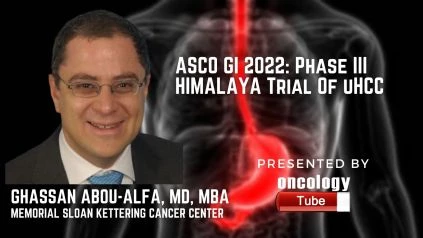Ghassan Khaled Abou-Alfa, MD, MBA, Medical Oncologist, Attending Physician at Memorial Sloan Kettering Cancer Center. In this video, he speaks about the ASCO GI 2022 Abstract – Phase 3 randomized, open-label, multicenter study of tremelimumab (T) and durvalumab (D) as first-line therapy in patients (pts) with unresectable hepatocellular carcinoma (uHCC): HIMALAYA.
Origins:
In a phase 2 uHCC study (Study 22, NCT02519348), a single priming dose of T (anti-CTLA-4) added to D (anti-PD-L1) in the STRIDE (Single T Regular Interval D) regimen, formerly T300+D, showed encouraging clinical activity and limited toxicity, suggesting that a single exposure to T is sufficient to improve D activity. In uHCC, the HIMALAYA study (NCT03298451) compared the effectiveness and safety of STRIDE or D vs sorafenib (S).
Methodologies:
HIMALAYA is an open-label, multicenter, phase 3 study in which patients with uHCC who had not received prior systemic therapy were randomized to STRIDE (T 300 mg plus D 1500 mg [one dose] plus D 1500 mg every 4 weeks [Q4W]), D (1500 mg Q4W), S (400 mg twice daily), or T 75 mg Q4W (4 doses) plus D 1500 mg Q4W (T75+D). After a planned analysis of Study 22 revealed that T75+D did not differ significantly from D, recruitment to T75+D was halted. The major goal was to compare STRIDE with S in terms of overall survival (OS). The OS noninferiority (NI) of D to S was the secondary goal (NI margin: 1.08). Progression-free survival (PFS), objective response rate (ORR; RECIST v.1.1), duration of response (DoR), and safety were all secondary goals.
Outcomes:
A total of 1171 points were randomly assigned to one of three groups: STRIDE (N=393), D (N=389), or S (N=389). The primary goal was achieved at data cutoff (DCO): STRIDE outperformed S in terms of overall survival (HR, 0.78; 96 percent confidence interval [CI], 0.65–0.92; p=0.0035; Table). D achieved the OS NI to S goal (HR, 0.86; 96 percent CI, 0.73–1.03). The ORRs for STRIDE (20.1%) and D (17.0%) were greater than those for S. (5.1 percent ). There were no new safety signals discovered. Treatment-related adverse events (TRAEs) of grade 3/4 occurred in 25.8% (STRIDE), 12.9 percent (D), and 36.9% (S) of patients. 5.9% (STRIDE), 5.2 percent (D), and 4.5 percent (S) of patients had grade 3/4 hepatic TRAEs. There was no TRAE of esophageal varices bleeding. 8.2 percent (STRIDE), 4.1 percent (D), and 11.0 percent (D) of TRAEs resulted in discontinuation (S).
Observations:
HIMALAYA was the first big phase 3 trial to test both mono- and combination immunotherapy in a heterogeneous, representative uHCC population with substantial long-term follow-up. D was non-inferior to S and had a higher level of safety. In STRIDE, a single priming dose of T + D showed improved efficacy and a good benefit-risk profile compared to S. STRIDE is a novel, first-line systemic therapy for uHCC that has been proposed. NCT03298451 is the number for the clinical trial.

